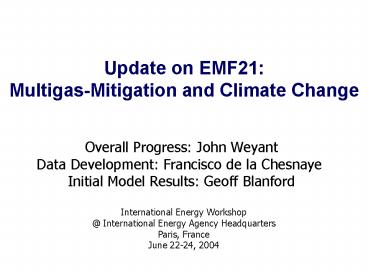Update on EMF21: Multigas-Mitigation and Climate Change
1 / 15
Title:
Update on EMF21: Multigas-Mitigation and Climate Change
Description:
Introduction to Multi-GHG Analysis John) Introduction to the EMF 21 Study (John) ... Argonne Nat Lab (Don Hanson) & EPA (Skip Laitner) with AMIGA ... – PowerPoint PPT presentation
Number of Views:12
Avg rating:3.0/5.0
Title: Update on EMF21: Multigas-Mitigation and Climate Change
1
Update on EMF21Multigas-Mitigation and Climate
Change
Overall Progress John Weyant Data Development
Francisco de la Chesnaye Initial Model Results
Geoff Blanford
International Energy Workshop _at_ International
Energy Agency Headquarters Paris, France June
22-24, 2004
2
Outline
- Introduction to Multi-GHG Analysis John)
- Introduction to the EMF 21 Study (John)
- Data Development on Non-CO2 GHG (John)
- Results part A Non-CO2 GHGs (Geoff)
- Results part B Recent EMF 21 Scenario Runs
(Geoff)
3
2000 Global Net GHG Emissions
Total 11,330 MMTCE
Sources EPA, EMF21, CDIAC
4
Stanford Energy Modeling Forum
- Established in 1976 to provide a structured forum
within which energy experts from government,
industry, universities, and other research
organizations could meet to study important
energy and environmental issues of common
interest - Objectives
- Understand Model Differences
- Communicate Insights to Policy Makers
- Identify Critical Research Needs
- Help Fill the Gaps in Data/Research
- EMF-21 Multi-Gas Mitigation and Climate Change
- Working Group Chairman Francisco de la Chesnaye,
USEPA - Study Objective Compare and contrast CO2-only
mitigation vs. multi-gas mitigation for given
scenarios and targets - More at http//www.stanford.edu/group/EMF/home/ind
ex.htm
5
EMF 21 Working Group Objectives
- 1) Conduct a new comprehensive, multi-gas policy
assessment to improve the understanding of the
affects of including non-CO2 GHGs (NCGGs) and
sinks (terrestrial sequestration) into short- and
long-term mitigation policies. Answer the
question How important are NCGGs Sinks in
climate policies?. - 2) Advance the state-of-the-art in integrated
assessment / economic modeling - 3) Strengthen collaboration between NCGG and
Sinks experts and modeling teams - 4) Publish results in a special issue of the
Energy Journal late in 2004/early 2005
6
Economy, Technology, Integrated Assessment
Models (18) Asia / Australia ABARE (Guy Jakeman
Brian Fisher) with GTEM Energy Research
Institute China (Jiang Kejun) with IPAC IAE Japan
(Atsushi Kurosawa) with GRAPE Indian Institute of
Management (P. Shukla) with SGM-India National
Institute for Environmental Studies, Japan
(Junichi Fujino) with AIM Europe CEA - IDEI
(Marc Vielle) with GEMINI-E3 CICERO - University
of Oslo (H.A. Aaheim) with COMBAT Cntr for
European Econ Research-(C. Boehringer A.
Loschel) with EU PACE Copenhagen Economics
(Jesper Jensen) with the EDGE Model Hamburg
Univ. (Richard Tol) with FUND IIASA (Shilpa Rao)
with MESSAGE Oldenburg University, Germany
(Claudia Kemfert) with WIAGEM RIVM (Detlef van
Vuuren, Tom Kram, Bas Eickhout) with IMAGE
UPMF (Patrick Criqui) CIRAD (Daniel Deybe)
with POLES/AGRIPOL US Argonne Nat Lab (Don
Hanson) EPA (Skip Laitner) with AMIGA EPRI
(Rich Richels) Stanford Univ (Alan Manne) with
MERGE MIT (John Reilly) with EPPA PNNL-JGCRI (Jae
Edmonds, Ron Sands, Steve Smith) with SGM
MiniCAM
7
Non-CO2 GHG Experts Dina Kruger and Francisco de
la Chesnaye, USEPA Paul Freund and John Gale, IEA
Greenhouse Gas RD Programme Methane N2O Ann
Gardiner, Judith Bates, AEA Technology Casey
Delhotal, Dina Kruger, Elizabeth Scheehle,
USEPA Chris Hendriks, Niklas Hoehne,
Ecofys Fluorinated (HGWP) Gases Jochen Harnish,
Ecofys, Germany Deborah Ottinger and Dave Godwin,
USEPA Sinks (Terrestrial Sequestration) Bruce
McCarl, Texas AM Ken Andrasko, USEPA Jayant
Sathaye, LBNL Roger Sedjo, RFF Brent Sohngen,
Ohio State Univ Ron Sands, PNNL-JGCRI
8
Non-CO2 GHG data requirements
- Global, consistent non-CO2 GHG emission baselines
for 2000 and projections to 2020 by region. And
key emissions drivers. - Comparable marginal abatement curves
- by region, by gas, and by sector
- sensitivities to energy, material prices
- in MMTCE w/ 100-yr GWP gas specific units
- Various discount and tax rates
- Assessment of how marginal abatement curves vary
over time, from 2010 to 2100 by decade.
9
(No Transcript)
10
Causal Chain
Demographic/Socio-economic/Tech. futures
Emissions
Concentrations
Climate change
Impacts
Source Rich Richels, EPRI
11
EMF 21 ScenariosPurpose Model Development,
Comparison, and Sensitivity Analyses
- 1) Modelers Reference Case
- 2) Long-term, Cost-minimizing
- Case A - achieved through CO2 mitigation only,
and - Case B - achieved through multi-gas mitigation.
- Climate Change Target Stabilize radiative
forcing at 4.5 W/m2 relative to pre-Industrial
times by 2150. - Time frame 2000 to 2100. From 2002 to 2012,
Kyoto Protocol is NOT in reference scenario. - Emissions Based on meeting climate target at
lowest global cost.
12
EMF 21 Scenarios
- 3) Combined Decadal Rate of Change and Long-Term
Cost-minimizing - Achieved through multi-gas mitigation.
- Climate Change Target Hold global mean decadal
rate of temperature change from 2010 to 2100 at
0.2ºC. (starting in 2030) and meet LT at 4.5 W/m2
by 2150. - Time frame 2000 to 2100. From 2002 to 2012, KP
is NOT in reference scenario. - Emissions Based on meeting climate target at
lowest global cost. - 4) CO2, Multigas Sinks with selected price
path(s)
13
Regional Methane Marginal Abatement Curves for
Energy Waste Sectors 2010
14
Global Non-CO2 Marginal Abatement Curves for
Energy, Industry Waste Sectors 2010
15
Contact Information
Professor John P. Weyant Director, Energy
modeling Forum Stanford University Stanford, CA
94305-4026 Phone (650)-723-3506 E-mail
weyant_at_stanford.edu
- Francisco de la Chesnaye
- Lead Economist, Non-CO2 Gases Sequestration
- U.S. Environmental Protection Agency
- Washington, DC 20460
- Tel 202-3439010
- E-mail delachesnaye.francisco_at_epa.gov































